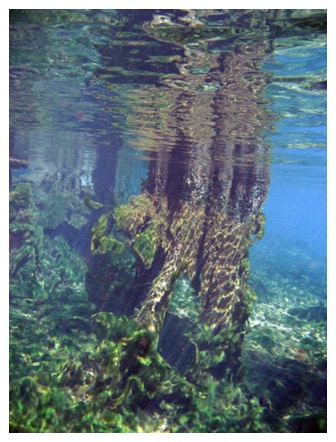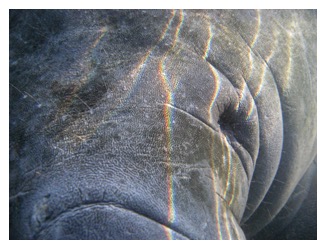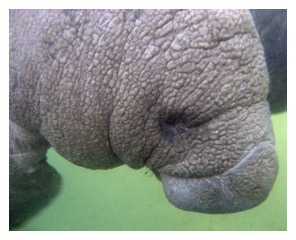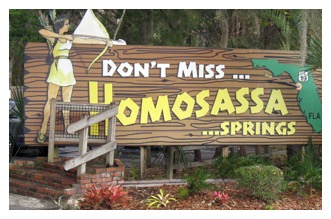January 17-20, 2014
Chiefland and Crystal River, FL
On the Martin Luther King, Jr holiday weekend this year, I led my first trip for WNG. This trip had been in the planning since last summer, so it was exciting and unsettling to, at last, have it all come to being.

Six WNG members and I travelled to Manatee Springs, FL where we camped for three nights. The campground had a canoe/kayak rental, with access to the Suwannee River; 8.5 miles of hiking trails; and a spring where campers could swim, snorkel, or SCUBA dive. It was cold in Florida, and I quickly realized that the crystalline spring water looked cold to me. I looked at that spring and saw ice; chilly as I was dry and cocooned in fleece, the idea of getting into the water was not immediately appealing. It required a psychological shift, a conscious effort to overcome the unconscious association of clear water with cold, to remind myself that the water was a constant 72º, year-round. Even reminding myself of that, it was a bit of a shock to reach down and feel the relative warmth of the water.
My group paddled; we snorkeled; we spent a lot of time gathered close to the campfire. Saturday night, we had a potluck.
Sunday morning, it was up at 6am for a 90-minute drive to Crystal River for the main event of the trip, swimming with the endangered West
Indian manatee. The happy side of the cold weather that plagued us camping in our tents was that it had driven a record number of manatees seeking the warmth of the springs in out of open water. The week before our arrival, the Florida Fish and Wildlife Service did its annual count of manatees in King’s Bay and counted 540, more than had ever been counted since FWS began taking counts in 1983.
Only in two places in Florida are you allowed to swim with manatees and only with those licensed by the state to provide these tours. I had done the tour with Capt Mike Dunn before, but in the spring time, after the algae was already reestablished itself following the winter die-back. We encountered manatees, but couldn’t really see them. Now it was January, and one of the coldest Januarys in memory. The water was clear, and the manatees were everywhere.
Capt Mike and his wife Capt Stacy run two small boats, maximum six per boat, a far more satisfactory way to do this tour than on a pontoon of 24 with screaming children, etc. Captains Mike and Stacy are utterly devoted to the welfare of the manatees, spending many of their off hours working with manatee rescue and rehabilitation and, in the off season, traveling to Belize to work with the Antilles manatee conservation efforts.
We headed to Three Sisters Springs where we got into our wetsuits and swam from the bay into the spring itself. It was magical. Manatees came up to us, nuzzled us, took us by the arm with their flippers, rolled over to be rubbed on their bellies. By the end of the day, many of us were wondering if it had really happened.
For a remarkable three minute video taken by Capt Mike, click here. I’m the guy in the sleeveless wetsuit who appears in about the first 90 seconds of the video. It’s difficult not to be dedicated to the cause after you’ve been cheek-to-cheek with a young manatee.
Our timing could not have been better. Difficult as it was to be up at 6am, we were grateful for Mike and Stacy’s insistence on an early start. About the time we’d enjoyed all the manatee play we could handle, the big boats full of noisy tourists were arriving. Conditions were so crowded, Capt Stacy reported to me later that, shortly after we left, the Florida FWS closed the spring to all swimmers and kayakers for the rest of the week.
After our manatee adventure, we went to a local restaurant for lunch, then on to Homosassa Springs. When I was a kid, we would pass
Homosassa Springs on our way up US 19 from south Florida to the panhandle where we would visit my great uncle, his wife, and his two sisters in Cypress, FL. In those days, Homosassa Springs was one of many commercial tourist attractions along Highway 19, replete with the now politically incorrect Indian squaw as its mascot and young dark-haired women who were costumed as Indians and worked in the park. We never went to Homosassa Springs when I was a child; we were always in a hurry to get where we were going, and Homosassa Springs was not inexpensive.
In recent years, the State of Florida has apparently taken over a lot of these 1950s era tourist attractions, many of them no long commercially viable with the extension of Interstate 75 deep into Florida, and has turned them into state parks. Homosassa Springs is now one of those parks and serves as a wildlife and manatee rehabilitation center. It retains vestiges of its days as a commercial enterprise, most notably the rhinoceros, a holdover from the small zoo that was part of the attraction. Excepting the rhino, almost all of the animals in the park now are native Florida species, specimens that have been injured or for some other reason are unfit to live in the wild. One of the residents is Rosie, a manatee who recently weighed in at 3500 pounds. Zaftig. Some of the animals will be rehabilitated and returned to the wild; others are permanent residents.
We returned to camp Sunday evening, had supper at a local barbecue joint, had one last evening around the fire. It was a wonderful group of men to spend the time with. We began referring to ourselves as “Miss Manatee and the Seven Dwarves.” We happened to be in Crystal Springs on the weekend of the annual manatee festival, and we did see Miss Manatee, but only from a distance. Miss Manatee was just one of many running jokes over the weekend. I laughed ’til my sides hurt. Those who prescribe laughter as therapy seem to me right on the mark. The next morning, broke camp and headed home.
For an album of photos from the manatee trip,
click here. Photos can be viewed as a slide show by double-clicking the first photo in the album, then using the arrow navigation buttons in the upper right to scroll through.




